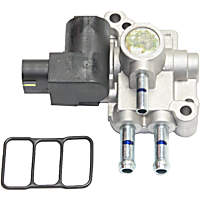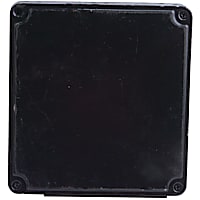In the not-so-distant past, nearly all cars had an idle air control valve (IAC). It’s a pretty simple device that controls idle speed by managing the amount of air bypassing the throttle plate.
Some IACs are stepper motors, while others are solenoids.
These days, most new cars have electronic throttle control (ETC), eliminating the need for an IAC. But there are still plenty of IAC-equipped vehicles on the road – and your car is probably one of them (otherwise, you wouldn’t be reading this article, would you?).
Knowing the symptoms and testing strategies associated with a bad IAC is helpful, especially if you’ve still got a vehicle with an IAC under the hood.

4 Common Idle Air Control Valve Symptoms
Here’s a surprise: A bad idle air control valve can affect idle speed—but that’s not all. Below are some of the most common symptoms of a faulty IAC:

Illuminated Check Engine Light
Your car’s primary computer, which is often referred to as the powertrain control module (PCM), controls and monitors the IAC. If the module detects a problem with the way the IAC is behaving, it will turn on the check engine light and store a corresponding diagnostic trouble code (DTC) in its memory.
Incorrect Idle Speed
As you probably guessed, a faulty IAC can result in an idle speed that’s either too high or too low, depending on whether the device is stuck open or stuck closed.
An idle speed that bounces up and down is also a possibility.
Stalling
Your car’s engine needs a precise mixture of air and fuel to run well. A faulty IAC can starve the engine of air at idle, resulting in stalling.
Engine Won’t Start
Although rare, there are instances where a faulty IAC can throw off the air/fuel mixture enough to prevent the engine from starting.
How to Test an Idle Air Control Valve
Vacuum leaks and circuit problems can mimic a bad IAC valve. That’s why it’s a good idea to test a suspect IAC before you rush out and buy a new one.
Without a doubt, using an OEM-level scan tool is the easiest way to test an IAC valve. OEM-level means the scanner has most of the same functions as the dealer’s factory tool. Code readers and OBD-II scan tools don’t have the necessary bi-directional controls to test an IAC.
OEM-level scan tools are awesome because, on many vehicles, you can directly control the IAC, taking the PCM completely out of the loop. Idle speed should increase as you incrementally open the valve, and decrease as you close the valve.
If the IAC does not respond to the scanner’s commands, the issue is either the IAC or its control circuit (excluding the PCM).

The problem is, most DIYers don’t have access to an OEM-level scan tool—which is why we’re going to discuss IAC troubleshooting with a code reader and digital multimeter (DMM).
Before beginning, however, you’ll want to have the vehicle’s repair information handy. Manuals, such as those from Chilton, are good, but an ALLDATA subscription is even better. The latter has single-vehicle subscriptions for DIYers that provide detailed factory repair information.
Note: The following are general guidelines for educational and entertainment purposes only. Consult your vehicle’s factory information for specific repair instructions and recommended safety procedures.
Step 1. Check for Diagnostic Trouble Codes (DTCs)
Is there an idle speed or other IAC-related DTC stored? Then there’s probably a problem with the IAC, a vacuum leak, or a problem with the IAC control circuit.
In most cases, cars built after 1996 with onboard diagnostics (OBD) II will set a code for a bad IAC. Many older cars with OBD I will also set a DTC when there’s a problem with the IAC. You can check for diagnostic trouble codes using a scan tool or code reader.
These days, you can even get an inexpensive code reader for your smartphone.
Step 2. Perform a Visual Inspection
If you find IAC or idle speed codes stored, you can move on to performing a visual inspection. You’ll want to look for issues, such as damaged hoses (creating vacuum leaks) and loose or broken wires going to the IAC. Also, check that the IAC’s electrical connector is clean and tight.
Repair any issues found during the visual inspection, clear the DTCs, and see whether the problem returns.

Step 3. Test the IAC Valve (Without an OEM-Level Scan Tool)
Because there are a variety of IAC designs in use today, there isn’t a one-size-fits-all way to pinpoint a failure on all vehicles. But the following tests will work on many applications.
Unplug the IAC Connector
On many vehicles, unplugging the IAC valve and listening for a change in RPMs will indicate whether the IAC and its circuit are intact.
Note: This test does not work on all vehicles. If you do not hear a change in RPMs, do not assume the IAC is bad until you do further testing. Also, this test may cause DTCs to set.
With the engine off, unplug the IAC. Then start the engine and listen for an idle speed that’s either too high, too low, or fluctuating.
Turn the engine off and plug the IAC back in. Restart the engine—idle speed should sound normal with the IAC plugged in.
An incorrect idle speed with the IAC unplugged (and a normal idle speed with the IAC connected) indicates the valve and its control circuit are working properly. There may be another problem, such as a vacuum leak causing your concern.
If you do not hear a change in idle speed, it’s possible that the IAC is faulty or there’s a problem with the valve’s control circuit (or this test does not apply to your vehicle).
Check the Resistance
One way you can check an IAC is by measuring its electrical resistance. Keep in mind, however, that this test is not conclusive. You’re only testing the electrical portion of the IAC, not the mechanical part.
To check resistance, you will need a repair manual and a digital multimeter (DMM).

Here’s how it’s done:
- Turn your multimeter to the ohms setting.
- Disconnect the IAC electrical connector.
- Consult a repair manual for the IAC resistance specifications and terminal identifications.
- Use your DMM to check the resistance between the terminals on the IAC (not the harness side of the connector). If the resistance values are outside specification, the IAC is likely faulty and needs to be replaced.
Remove the IAC and Check for Carbon Buildup and Debris
An IAC can be okay electrically (with good resistance values) but faulty mechanically. That’s why it’s a good idea to remove the IAC to check for excessive carbon buildup and debris.
You can try to clean the IAC with a throttle body cleaner. Afterward, clear any codes and see if the problem goes away and stays away. If the issue persists, you may need to replace the IAC, or there could be a circuit problem or vacuum leak you need to address.
Can You Continue Driving with a Bad Idle Air Control Valve?
Technically, you may be able to drive with a bad IAC—but you should not continue doing so. A bad IAC can potentially lead to stalling, which can compromise vehicle safety. Plus, you won’t pass a state emissions test if the check engine light is on due to a bad IAC.
As such, you should replace a faulty IAC as soon as possible.
Where to Get a New Idle Air Control Valve for Your Vehicle
Don’t let your vehicle gather dust in the garage for days because of a bad idle air control valve. If you’re having trouble finding a replacement for your ride in local auto parts shops, consider shopping online at CarParts.com.
Find exactly what you need in our user-friendly website with just a few clicks. Use our vehicle selector to start shopping for the parts you need. Then, narrow down the products according to your preferred brand, price range, quantity, etc. using the search filters.
Sourced from the top names in the industry, our idle air control valves come with a low-price guarantee. That means you can find a top-notch replacement without breaking the bank. They’re also on hand and ready to ship from a warehouse near you, so you can get your order in as fast as two business days.
Check out our idle air control valves, and shop now!
Products Mentioned in this Guide
Any information provided on this Website is for informational purposes only and is not intended to replace consultation with a professional mechanic. The accuracy and timeliness of the information may change from the time of publication.


 Idle Control Valve
Idle Control Valve
 Engine Control Module
Engine Control Module



























is it possible a temp sensor could case engine stalling and poor running after warm up on a 2001 Chevrolet Prism?